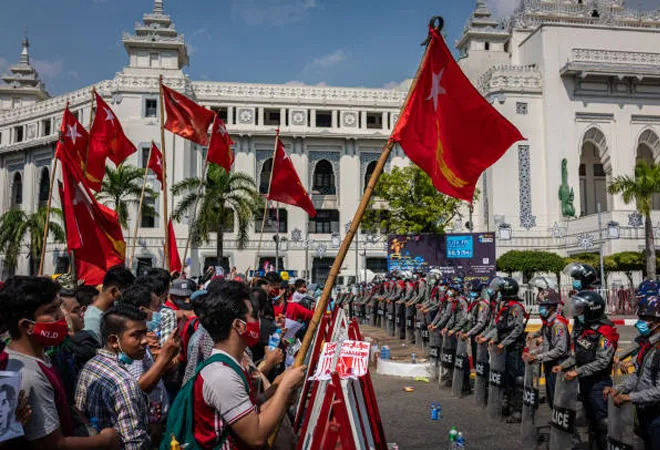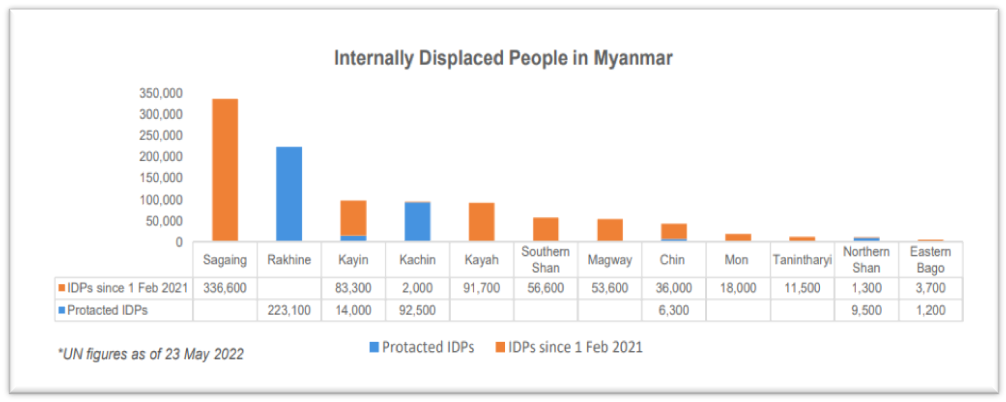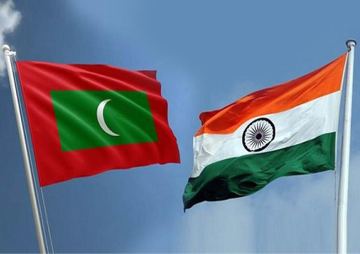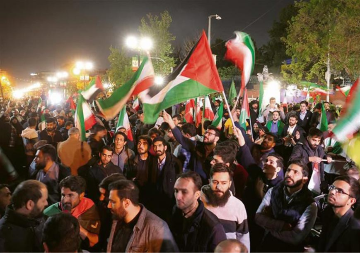
As the Myanmar 2021 coup has entered five months into its second year, the humanitarian situation of the nation is of deep concern. By 2022, the political and economic disorder in Myanmar drove almost half of the population, i.e., around 25 million individuals into poverty. COVID-19-related challenges, for instance, movement limitations, economic slowdown, coupled with the coup challenges of ongoing protests and rising insecurity, banking restrictions, restricted cash flows, and the junta’s deliberate blocking of aid have hindered the humanitarian response even as requirements have amplified. At least 425,000 people have been newly displaced since the coup, bringing the number to one million in 2022. Yet humanitarian access has decelerated as the military tries to subdue an armed resistance movement.
The recent approval of the death sentencing of former National League for Democracy lawmaker, Ko Phyo Zeya Thaw and veteran democracy activist Ko Jimmy, for their anti-regime activities, has showcased the atrocities that are going on under present rule.
According to the latest report in 2022, 14.4 million people need humanitarian assistance. The human security environment has deteriorated in many parts of Myanmar, including areas that had largely been spared civil conflict over recent years.
 Source:OCHA Myanmar, 31 May 2022,
Source:OCHA Myanmar, 31 May 2022,
According to the United Nations (UN) figures, thousands of Internally Displaced People (IDP) who have already escaped their homes or shelters are being forced to move again. Since the coup, approximately 40,000 people have crossed the borders into neighbouring countries such as Thailand and India. In 2021, more than 12,700 public properties, including households, and religious buildings like cathedrals, monasteries, and educational institutions have been demolished during conflicts. This has created a complex situation for the return of IDPs if new buildings are not built or better conditions for return do not prevail. On top of the continued fighting, severe storms and heavy rain have hit coastal areas of the country since April 2022. The rains in the low-lying areas in Kayin, Kachin, Rakhine, and Shan states, have severely damaged the houses and shelters. This has further heightened pre-existing vulnerabilities of the affected people, particularly IDPs in protracted displacement sites.
In addition to people displaced from conflict-ridden areas, urban places in the Yangon are experiencing food shortages and displacement. According to the International Labour Organization (ILO) 2022, 1.6 million have lost their employment. On top of this, the rising inflation has increased the pricing of basic commodities, including food and fuel; this is also partly due to the conflict in Ukraine. The price of diesel in Myanmar has increased by 27 percent from February to April 2022. On average, as of mid-April 2022, fuel prices are nearly two and a half times higher than in February 2021. This inflation has impacted people’s procurement ability and has caused food insecurity.
Response from humanitarian actors
Humanitarian actors have been quick to reach affected families and have provided non-food items like ropes, blankets, kitchen sets, mosquito nets, buckets, sleeping mats, sanitary kits, COVID-19 personal protective equipment, and solar lamps along with repair work and provisions of tarpaulins. World Food Program (WFP) has been working around the clock to provide life-saving food and nutrition assistance to conflict-affected people. In 2021, WFP has reached out to nearly three million people with food and nutrition assistance. This includes 56,000 IDPs in areas of conflict and 1.7 million people in urban areas. However, the needs far surpass present capacities, resources, and access.
World Food Program (WFP) has been working around the clock to provide life-saving food and nutrition assistance to conflict-affected people.
The military junta has limited humanitarian entrees across the country’s conflict zones. It has imposed blockades on supplies or has denied travel permissions. In the Chin state and the northwest part, the movement of goods has stopped almost completely and regular checks are taking place. As a result, there has been a major disruption in providing food or non-food items. The aid workers either take the help of ethnic armed groups or local people for their protection and also to ensure smooth delivery to the remotest of places and avoid the military channel of communication.
The humanitarian actors face grave danger whilst working with the IDPs since the military junta like before, is not distinguishing between civilians and ethnic armed groups, and thus is burning down properties and individuals. As of 2 June, the military has killed 1,883 people and has arrested more than 13,500. In December last year, two humanitarian workers were immolated along with other civilians by the junta and such instances are likely to amplify if the war-like situation doesn’t diffuse early. The protection of aid workers becomes paramount in this regard since they are delivering and taking care of people in need.
In addition to safety, more funding is critically needed to ensure efficient responses. As of the end of the first quarter of 2022, 2.6 million people have been reached with humanitarian assistance. However, 59 percent remain in need and thus funding becomes crucial. In 2022, only 10 percent has been funded, leaving a shortfall of US$740 million. Humanitarian players will be obligated to curtail their assistance at a time when this support is needed the most.
The regional bloc of ASEAN attempted to implement the humanitarian aid point within the five-point consensus but has come under condemnation since the ASEAN’s Chair Cambodia sought the military general’s approval and assistance to disburse the aid.
Response from regional actors
The UN Security Council has failed to adopt a proper plan to negotiate the delivery of humanitarian aid to Myanmar. The regional bloc of ASEAN attempted to implement the humanitarian aid point within the five-point consensus but has come under condemnation since the ASEAN’s Chair Cambodia sought the military general’s approval and assistance to disburse the aid. On 6 May, the ASEAN chair along with ASEAN Coordinating Centre for Humanitarian Assistance on disaster management centre (AHA) met with the Myanmar task force comprising humanitarian aid organisations like the Myanmar Red cross society that caters to the military directives, to decide the modalities of delivering aid of US$7 million and another US$700,000 worth of medical supplies and equipment towards the COVID-19 response to the population in need. Whilst the discussion was centered on the principle of leaving no one behind and it was a concern that all activities and programmes must be non-discriminatory and independent; the humanitarian groups, the UN, and National Unity Government (the government in exile) have pointed out that by including junta in the discussion they have failed to keep with the spirit of this theme since it is the Junta who is committing the atrocities on the said people in need.
Whilst the attempt of Cambodia to discuss modalities to disburse humanitarian aid is well-intended, ensuring the aid reaches the right people is a matter of concern. Analysts are advising that ASEAN must call on the UN Security Council to arrive at a directive of humanitarian intervention that includes the presence of aid and healthcare workers in the places of need.
It seems essential that international donors including ASEAN, the EU, the UK, the US, and UN agencies must partner with local agencies or actors and direct humanitarian aid through cross-border channels to ensure aid reaches people in need. A people-to-people approach will be needed to utilise prevailing community links that will ensure the proper delivery of aid. Coupled with this, funding on time will remain essential if appropriate mechanisms and delivery measures need to be successful.
The views expressed above belong to the author(s). ORF research and analyses now available on Telegram! Click here to access our curated content — blogs, longforms and interviews.





 PREV
PREV


